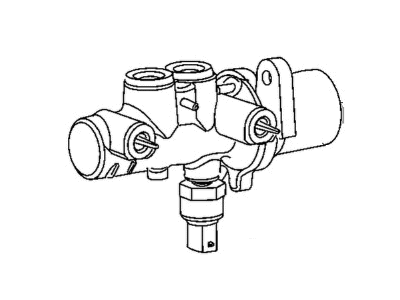×
- Live Chat
- 1-888-511-3595

My Garage
My Account
Cart
Genuine Dodge Magnum Brake Master Cylinder
- Select Vehicle by Model
- Select Vehicle by VIN
Select Vehicle by Model
orMake
Model
Year
Select Vehicle by VIN
For the most accurate results, select vehicle by your VIN (Vehicle Identification Number).
6 Brake Master Cylinders found
Dodge Magnum Brake Master Cylinder
The Brake Master Cylinder is an eminent part of Dodge Magnum vehicles; it squashes foot force into hydraulic pressure in order to control slave cylinders. This system applies a force by utilizing hydraulic fluid to transmit force of the master cylinder's piston to the slave cylinders; force as well as displacements are improved. Indeed, Dodge Magnum vehicles utilize a dual circuit master cylinder with two plungers, and it means that even if the hydraulic pressure in one circuit is lost, another one will be capable of supplying sufficient pressure for the car to be stopped. Master cylinder helps to work the calipers or drum brakes which are frictional parts that help to stop wheels besides helping to operate slave cylinder to release the clutch. Through controlling of hydraulic force and the pressure, Brake Master Cylinder performs a crucial task of proper working of the car's Braking System as well as Clutch System.
Looking for affordable and high-quality auto parts? Then you have already arrived at the proper online shop. We offer all Dodge Magnum Brake Master Cylinder at great affordable prices. Moreover, all genuine Dodge Magnum Brake Master Cylinder come with a manufacturer's warranty. In the long run, you would realize you have saved a lot of trouble and money with OEM parts from here.
Dodge Magnum Brake Master Cylinder Parts Questions & Experts Answers
- Q: How Should I Remove and Install a Master Cylinder on Dodge Magnum?A: Brake fluid can damage paint or finished surfaces, so it is important to cover all body parts and be cautious not to spill any fluid during the removal process. Any spilled brake fluid should be cleaned up immediately and the area should be washed with large amounts of water. It is also important to note that different vehicle models may have different factory systems installed for the Anti-lock brake system (ABS), so it is necessary to determine which system is on your vehicle for part identification and torque specifications. To begin the removal process, disconnect the cable(s) from the negative battery terminal(s) and depress the brake pedal several times to remove all vacuum from the power Brake Booster. Remove the brake master cylinder access cover in the cowl and clean the brake master cylinder and reservoir thoroughly with brake cleaner. Remove as much fluid as possible from the reservoir with a syringe and unplug the electrical connector for the brake fluid level warning switch. Place rags under the fittings and prepare caps or plastic bags to cover the ends of the lines once they're disconnected. Loosen the fittings at the ends of the Brake Lines where they enter the brake master cylinder using a flare-nut wrench and carefully move the brake lines away from the brake master cylinder, plugging the ends to prevent contamination. Remove the brake master cylinder mounting nuts and pull the brake master cylinder off the studs to remove it, being careful not to spill fluid or bend the brake lines. To install the new brake master cylinder, bench bleed it before installing by mounting it in a vise and attaching a pair of brake master cylinder bleeder tubes to the outlet ports. Fill the reservoir with brake fluid and slowly push the pistons into the brake master cylinder using a large Phillips screwdriver to expel air from the pressure chambers. Repeat this procedure until no more air bubbles are present and remove the bleed tubes, installing plugs in the open ports to prevent fluid leakage and air from entering. Install a new vacuum seal on the brake master cylinder and then install the reservoir cover. Install the brake master cylinder over the studs on the power brake booster and tighten the attaching nuts finger tight. Thread the brake line fittings into the brake master cylinder, being careful not to strip the threads, and tighten the mounting nuts and brake line fittings securely. Fill the brake master cylinder reservoir with the correct fluid and bleed the brake system as described. Finally, test the operation of the brake system carefully before placing the vehicle into normal service.







